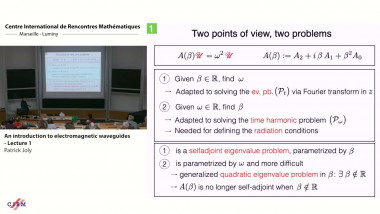
An introduction to electromagnetic waveguides - Lecture 1
De Patrick Joly
Apparaît dans la collection : Wave propagation in guiding structures / Propagation d'ondes dans les structures guidées
My course builds upon the one taught by Patrick Joly. I will focus on studying the modes of an electromagnetic waveguide when we adopt what he called the second point of view : for a given real frequency ω, look for the possible axial wave numbers β. This is a quadratic eigenvalue problem. Except in the homogeneous case, it cannot be rewritten as a self-adjoint eigenvalue problem. Even more, its properties are typical of a non-selfadjoint eigenvalue problem, like for instance the possible existence of Jordan's blocks, at particular frequencies. It is interesting to notice the analogy with the case of elastic waveguides, which present such non-selfadjoint characteristics even in the homogeneous case (Lamb modes). In the first part of my talk, I will give a brief summary of Patrick's lecture, with some complements that will be useful in the second part. In particular, I will establish some bounds on the dispersion curves of heterogeneous waveguides, using min-max formulas. Then, I will consider the quadratic eigenvalue problem in β. The first challenge lies in proving that the eigenvalues β, for a given frequency ω, form a discrete set in the complex plane. We will present the method used to establish this result in an abstract framework, which we will then apply to both elastic and electromagnetic waveguides, facing different difficulties. We will also examine the symmetry properties of the spectrum and its location within a double sector of the complex plane. In the case of electromagnetic waveguides, we use a so-called augmented formulation of Maxwell equations: this leads to a new quadratic eigenvalue problem whose study is much simpler than the original one, and whose set of eigenvalues contains the eigenvalues of the original problem. A stronger result has been obtained recently, which proves that there exist, at a given frequency, infinitely many eigenvalues β. This is a byproduct of a completeness result, based on Keldysh theorem. The last part of the course will be devoted to inverse modes, which are propagating modes with phase velocity ω/β and group velocity dω/dβ of opposite signs. Using again the augmented formulation, I will clarify the role of the heterogeneity in the mechanism of appearance of inverse modes.
